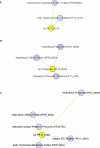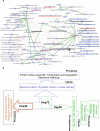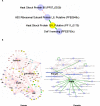Systems analysis of chaperone networks in the malarial parasite Plasmodium falciparum
- PMID: 17941702
- PMCID: PMC1976336
- DOI: 10.1371/journal.pcbi.0030168
Systems analysis of chaperone networks in the malarial parasite Plasmodium falciparum
Abstract
Molecular chaperones participate in the maintenance of cellular protein homeostasis, cell growth and differentiation, signal transduction, and development. Although a vast body of information is available regarding individual chaperones, few studies have attempted a systems level analysis of chaperone function. In this paper, we have constructed a chaperone interaction network for the malarial parasite, Plasmodium falciparum. P. falciparum is responsible for several million deaths every year, and understanding the biology of the parasite is a top priority. The parasite regularly experiences heat shock as part of its life cycle, and chaperones have often been implicated in parasite survival and growth. To better understand the participation of chaperones in cellular processes, we created a parasite chaperone network by combining experimental interactome data with in silico analysis. We used interolog mapping to predict protein-protein interactions for parasite chaperones based on the interactions of corresponding human chaperones. This data was then combined with information derived from existing high-throughput yeast two-hybrid assays. Analysis of the network reveals the broad range of functions regulated by chaperones. The network predicts involvement of chaperones in chromatin remodeling, protein trafficking, and cytoadherence. Importantly, it allows us to make predictions regarding the functions of hypothetical proteins based on their interactions. It allows us to make specific predictions about Hsp70-Hsp40 interactions in the parasite and assign functions to members of the Hsp90 and Hsp100 families. Analysis of the network provides a rational basis for the anti-malarial activity of geldanamycin, a well-known Hsp90 inhibitor. Finally, analysis of the network provides a theoretical basis for further experiments designed toward understanding the involvement of this important class of molecules in parasite biology.
Conflict of interest statement
Figures




Similar articles
-
Chaperoning a cellular upheaval in malaria: heat shock proteins in Plasmodium falciparum.Mol Biochem Parasitol. 2007 Jun;153(2):85-94. doi: 10.1016/j.molbiopara.2007.01.009. Epub 2007 Jan 17. Mol Biochem Parasitol. 2007. PMID: 17307260 Review.
-
The Plasmodium falciparum Hsp70-x chaperone assists the heat stress response of the malaria parasite.FASEB J. 2019 Dec;33(12):14611-14624. doi: 10.1096/fj.201901741R. Epub 2019 Nov 14. FASEB J. 2019. PMID: 31690116 Free PMC article.
-
Chaperone expression profiles correlate with distinct physiological states of Plasmodium falciparum in malaria patients.Malar J. 2010 Aug 19;9:236. doi: 10.1186/1475-2875-9-236. Malar J. 2010. PMID: 20719001 Free PMC article.
-
(-)-Epigallocatechin-3-Gallate Inhibits the Chaperone Activity of Plasmodium falciparum Hsp70 Chaperones and Abrogates Their Association with Functional Partners.Molecules. 2017 Dec 5;22(12):2139. doi: 10.3390/molecules22122139. Molecules. 2017. PMID: 29206141 Free PMC article.
-
The Hsp40 proteins of Plasmodium falciparum and other apicomplexa: regulating chaperone power in the parasite and the host.Int J Biochem Cell Biol. 2007;39(10):1781-803. doi: 10.1016/j.biocel.2007.02.011. Epub 2007 Feb 22. Int J Biochem Cell Biol. 2007. PMID: 17428722 Review.
Cited by
-
Characterization of HSP90 isoforms in transformed bovine leukocytes infected with Theileria annulata.Cell Microbiol. 2017 Mar;19(3):e12669. doi: 10.1111/cmi.12669. Epub 2016 Oct 20. Cell Microbiol. 2017. PMID: 27649068 Free PMC article.
-
Violacein-Induced Chaperone System Collapse Underlies Multistage Antiplasmodial Activity.ACS Infect Dis. 2021 Apr 9;7(4):759-776. doi: 10.1021/acsinfecdis.0c00454. Epub 2021 Mar 10. ACS Infect Dis. 2021. PMID: 33689276 Free PMC article.
-
Characterisation of the Plasmodium falciparum Hsp70-Hsp90 organising protein (PfHop).Cell Stress Chaperones. 2012 Mar;17(2):191-202. doi: 10.1007/s12192-011-0299-x. Epub 2011 Oct 18. Cell Stress Chaperones. 2012. PMID: 22005844 Free PMC article.
-
Construction of a Plasmodium falciparum Rab-interactome identifies CK1 and PKA as Rab-effector kinases in malaria parasites.Biol Cell. 2012 Jan;104(1):34-47. doi: 10.1111/boc.201100081. Epub 2011 Dec 6. Biol Cell. 2012. PMID: 22188458 Free PMC article.
-
A heat-shock response regulated by the PfAP2-HS transcription factor protects human malaria parasites from febrile temperatures.Nat Microbiol. 2021 Sep;6(9):1163-1174. doi: 10.1038/s41564-021-00940-w. Epub 2021 Aug 16. Nat Microbiol. 2021. PMID: 34400833 Free PMC article.
References
-
- Smith DF, Whitesell L, Katsanis E. Molecular chaperones: Biology and prospects for pharmacological intervention. Pharmacol Rev. 1998;50:493–514. - PubMed
-
- Neupert W. Protein import into mitochondria. Annu Rev Biochem. 1997;66:863–917. - PubMed
-
- Sato N, Torigoe T. The molecular chaperones in cell cycle control. Ann N Y Acad Sci. 1998;851:61–66. - PubMed
-
- Pratt WB. The Hsp90 based chaperone system: Involvement in signal transduction from a variety of hormone and growth factor receptors. Proc Soc Exp Biol Med. 1998;214:420–434. - PubMed
Publication types
MeSH terms
Substances
LinkOut - more resources
Full Text Sources
Medical

